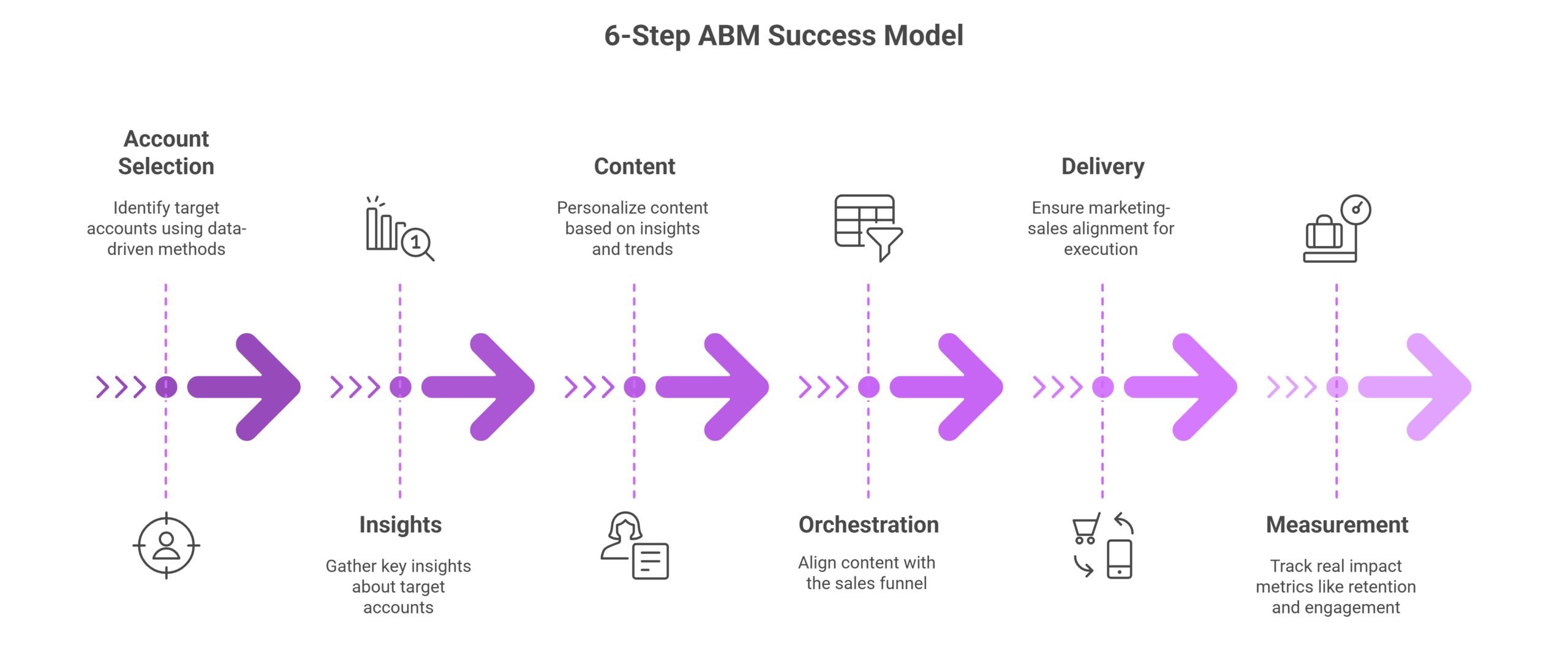Account-Based Marketing Success Model to Drive B2B ROI
Learn the 6-step ABM success model from account selection to measurement—to boost engagement, pipeline growth, and B2B conversions.

According to various research studies that have been conducted, Account-Based Marketing (ABM) outperforms other marketing channels and brings in a higher ROI. It is quickly becoming a must-have for B2B marketers. If you are one of the 71% of B2B organizations who are interested in adopting ABM but are struggling to do so then read on to discover the ABM model that is critical to a successful ABM implementation.
Keep in mind that there isn’t just one path that companies can take when implementing ABM. Rather, every company is different and have their own challenges, goals and technology stacks but this is the basic model that will get you well on your way to ABM success.
The ABM Success Model
1 Account Selection
A study conducted by SiriusDecisions. proved that better account selection stems from better data which ultimately leads to a 35-40% higher average sales selling price. Equipped with the right data you will, scientifically, be able to identify accounts that have the highest likelihood of doing business with you and which of your existing customers are willing to expand.
Keeping in mind firmographics (company characteristics) and technographics (technologies used by those accounts) will help you in drawing better company-level insights.
2. Insights
Within the accounts, you have decided to target, invest time and resources in researching their place on the organizational chart, personal goals, and their influence level. Apart from these, there are specific details that need to be known about the customer before reaching out to them.
- Job title
- Tenure
- Decision-making hierarchy
- Account affiliation
- Activity/engagement history
- Skills and proficiencies
- Experience with your category
3. Content
According to a survey conducted by ITSMA, 75% of executives welcome even unsolicited material if and when the ideas are relevant to their business. After the right target accounts and the right buying centers (ones who actually influence and make purchase decisions) have been selected, it is imperative that the relevant business insights are delivered.
The data you need to possess in order to organize your account based plays effectively are:
- The target account’s industry and market trends
- SWOT analysis of the target account
- The relationships inside the account
- Your connection to the account
When you provide relevant content, you generate credibility, trust, and ultimately more business.
4. Orchestration
Many ABM strategies fail here as they lack variation in their content which leads to a lack of engagement with the right audience. The reason for this is that many marketers classify themselves into creating content for just a single purpose which could be either for the top of the funnel (awareness-generating type content) or for the bottom of the funnel (conversion-generating type content). Additionally, they end up grouping accounts together which leads to the application of the same-old, broad-based marketing but just to a narrower pool.
In order to not ignore the other stages of the buying journey, your ABM strategy needs to align with your content strategy. A strong content strategy leads to a better experience for the leads that are traveling from marketing to sales.
It is also vital to segment your accounts so that marketing campaigns can work as specialized, diagnostic communications.
5. Delivery
During this stage, establish and solidify a business relationship with the prospect’s department or division and then expand that relationship to other sectors. For the execution and success of this approach, your marketing and sales teams need to be in complete alignment with each other.
Marketing is responsible for getting sales to the accounts and ensuring that sales enter in a way that leads to more marketing opportunities. Sales, in turn, should be kept abreast about any offerings, marketing messages, or campaign themes.
6. Measurement
B2B marketers often report on campaign-related metrics that are helpful in diagnosing the performance of the program but fail at reflecting the business impact. Close rates, retention, upselling and annual contract value need to be the metrics that B2B marketers measure to understand the true impact of ABM.
ABM Measurement Analytics:
- Coverage – From target account list to individual account, examine the CRM data you have amassed relative to actual employees that fit your target account profile. Opportunity areas can be determined by the role and level of seniority.
- Reach – Ensure your programs are aimed at the right people. Increase in activity within your marketing programs is great but if your target accounts aren’t a priority for those programs, and your programs aren’t built around them, then you’ll never achieve your objectives.
- Engagement – Determine the target account you are trying to impact and the one who actually responds to your marketing programs. From the target list to account, to role within those accounts, you can bring focus on what’s working.

Case Study
Challenge:
SAP, a market leader in enterprise software faced a challenge that was centered on their large customer base and their extensive service list. 10% of SAP America’s accounts were responsible for a third of the revenue in the region. They knew that they were reaching their accounts regularly through their marketing activity, but on closer inspection, they realized that those marketing touches were not personalized or customized to that account.
Solution:
To better cater to these top accounts, the SAP team decided to implement an account-based marketing program, the goal of which was to offer dedicated marketing plans for select accounts.
Result:
After just 2 years of implementation, SAP saw impressive results from its account-based marketing program and had created $27 million in new pipeline opportunities which then progressed to $57 million down the pipeline!
Conclusion
In this World, where personalized marketing encompasses various spheres of our lives, highly relevant and targeted communication is expected and preferred by B2B clients. Globally, ABM has been making huge strides with a 21% increase in the number of organizations that have fully adopted this program.
With proper planning and resource allotment, account-based marketing produces the best results. Even though it will take time to see your efforts pay off, in the long run, this initial due diligence will pay for itself many times over.



